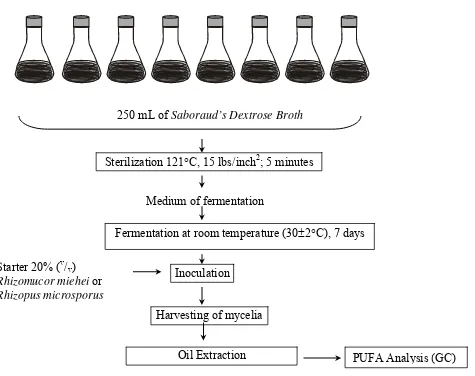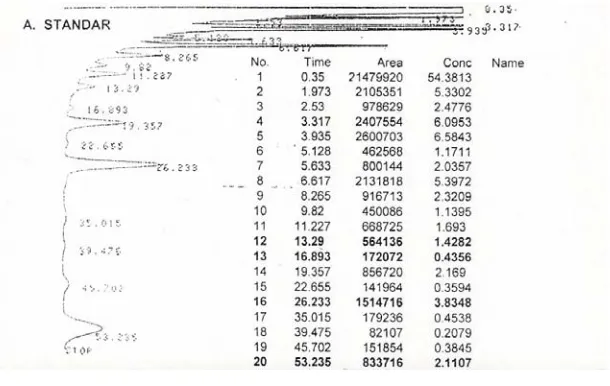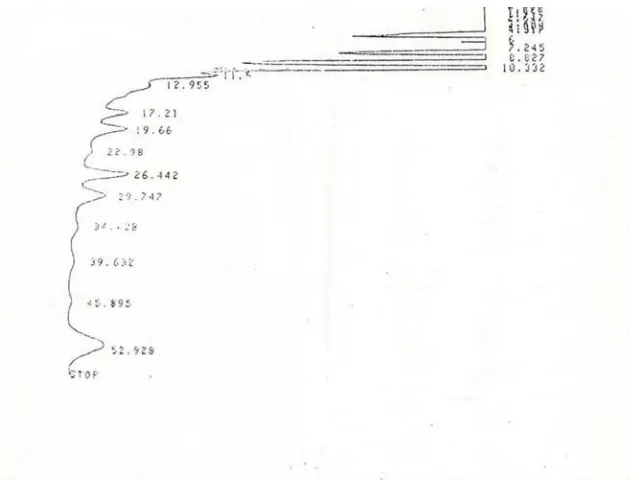Asian Journal of
Food and Agro-Industry
ISSN 1906-3040 Available online at www.ajofai.info
Research Article
Production of polyunsaturated fatty acids with
Rhizomucor
miehei
by submerged fermentation
Ignatius Srianta1*, Ira Nugerahani2 and Netty Kusumawati2
1Centre for Food and Nutrition Research, Widya Mandala Surabaya Catholic University, Jl Dinoyo 42-44 Surabaya 60265 Indonesia.
2MicrobiologyLaboratory, Food Technology Department, Faculty of Agricultural Technology, Widya Mandala Surabaya Catholic University, Jl Dinoyo 42-44 Surabaya 60265 Indonesia.
*Author to whom correspondence should be addressed, email: srianta_wm@yahoo.com
This paper was originally presented at the International Conference of the Indonesian Society of Microbiologists, November, 2009.
Abstract
The w-3 and w-6 series of polyunsaturated fatty acids (PUFA) have shown tremendous potential for use in food additives and pharmaceuticals for heart and circulatory disorders and cancer as well as inflammatory diseases. The submerged culture is usually used for PUFA production with glucose or glycerol as a carbon source. PUFA production with Rhizomucor miehei by submerged fermentation has been studied. Rhizomucor miehei showed a greater potentiality than Rhizopus microsporus to produce polyunsaturated fatty acids by submerged fermentation. Rhizomucor miehei produced linoleic acid of 12,31%, linolenic acid of 5,78%, eicosapentaenoic acid of 0.67% and docosahexaenoic acid 1,10% in the Saboraud Dextrose Broth medium at 30oC for 7 days. Linoleic acid, linolenic acid, eicosapentaenoic acid and docosahexaenoic acid was determined by Gas Chromatography (GC). Rhizomucor miehei also showed the potentiality to produce linoleic acid, linolenic acid, eicosapentaenoic acid and docosahexaenoic acid with cane molasses, wheat bran and pollard as medium. The result showed that cane molasses was the most effective as medium for PUFA production than wheat bran and pollard. 15% of cane molasses was the optimum concentration for eicosapentaenoic acid and docosahexaenoic acid production. At the concentration, Rhizomucor miehei produced eicosapentaenoic acid and docosahexaenoic acid of 0.86% and 0.82%, respectively.
Introduction
Polyunsaturated Fatty Acids (PUFA) are long chain fatty acids with two or more of double bounds. PUFA control the expression of certain genes and thus affect some processes including fatty acids biosynthesis and cholesterol transport in the body. The second function is that PUFA serve as precursors of a wide variety of metabolites, such as prostaglandins, leukotrienes and hydroxy-fatty acids, which regulate critical biological functions. The various roles played by PUFA make it apparent that they are required in every organ in the body in order to keep the organ functioning normally. Therefore, it is not surprising that PUFA deficienies lead to abnormalities in the skin, nervous system, immune and inflammatory system, cardiovascular system, endocrine system, kidneys, respiratory and reproductive systems [1]. The w-3 and w-6 series of PUFA have shown tremendous potential for use in food additives and pharmaceuticals for heart and circulatory disorders and cancer as well as inflammatory diseases [2, 3].
PUFA occur throughout the animal and plant kingdom, although the greatest diversity is encountered in microorganisms especially algae, fungi and bacteria. In microorganisms, the fatty acids are typically present in storage oil and in membrane phospholipids [1]. PUFA yields in agricultural and animal products are generally low and vary by season, climate and geographical location. Marine fish oil, which are the main source of commercial EPA and DHA, have disadvantages of objectionable taste and odors, high cholesterol and small amount of potential toxic impurities that are difficult to remove. Therefore, the quantity and quality of conventional sources of PUFA may encounter problems meeting an increasing market demand [1].
A variety of PUFA have been detected in microorganisms including bacteria (Bacillus megaterium, Bacillus pumilus and Pseudomonas aeruginosa); yeasts (Candida curvata, Rhodotorula glutinis, Lipomyces lipofer); fungi (Aspergillus terreus, Claviceps purpurea, Mucor ramannianus, Tolyposporium ehrenbergii and Mortierella alpina) [4, 5]. Microorganisms are thought to be very promising lipid producers because of their high growth rate on simple media and the simplicity of their manipulation. Rhizomucor miehei and Rhizopus microsporus are a group of fungi found to produce linolenic acid, however production of other PUFA have not been studied.
The submerged culture is usually used for PUFA production with glucose or glycerol as a carbon source. In addition, culture media and culture conditions affect the quality and the quantity of PUFA production [2]. Agricultural wastes, such as cane molasses, wheat bran and wheat pollard, contain carbohydrates and other nutrients which can be used as substrate for fermentation. Wheat bran and pollard have been used to produce monascus pigment with fungi Monascus purpureus [6].
The objectives of this research were to firstly study PUFA production with Rhizomucor miehei and Rhizopus microsporus and to then study PUFA production with Rhizomucor miehei by submerged fermentation on cane molasses, wheat bran and wheat pollard.
Materials and Methods
Materials
Yogyakarta. Cane molasses was obtained from Kebonagung Sugar Cane Factory, Malang, East Java. Wheat bran and pollard were obtained from PT Bogasari Flour Mills, Indofood Sukses Makmur, Surabaya, East Java. Chemicals were obtained from a local supplier.
Production of PUFA with Rhizomucor miehei and Rhizopus microsporus
Production of PUFA was undertaken by submerged fermentation on the same medium and conditions of fermentation as shown in Figure 1.
Figure 1. Production of PUFA by Submerged Fermentation.
PUFA production with Rhizomucor miehei on cane molasses, wheat bran and pollard
Rhizomucor miehei was chosen for further research since it showed higher PUFA productivity than Rhizopus microsporus. Production of PUFA with Rhizomucor miehei was undertaken by submerged fermentation on cane molasses, wheat bran and wheat pollard.
Oil Extraction
Oil extraction was performed according to Indrati et al [7]. Harvested mycelia was freeze dried at -40oC for 24 hours, then crushed manually by mortar. 100 mL of chloroform was added to the crushed mycelia, then sonicated for 10 minutes, filtered with Whatman 40 filter paper. Solvent of the filtrate was evaporated by rotary vaccuum evaporator at 40oC. Residual oil was analysed for PUFA composition using gas chromatography.
250 mL of Saboraud’s Dextrose Broth
Sterilization 121C, 15 lbs/inch2; 5 minutes
Medium of fermentation
PUFA analysis using gas chromatography
Extracted oil was analysed of the PUFA using Gas Chromatography (GC) with standard of mixture of fatty acids containing Linoleic acid, Linolenic Acid, EPA and DHA. Oil was methylated by KOH 2 N in methanol to produce Fatty Acid Methyl Ester (FAME). 1 µL of FAME was injected to GC column with below condition: column (2 m length, 3.3 mm ID, DEGS (Diethyl Glycol Sucinat), Chromosorb 80 – 100 mesh) with temperature program from 190oC to 250oC and temperature gradient 10oC/min, mobile phase (N2 with flow rate of 30
mL/min), FID detector with H2 and O2 pressure of 1 kg/cm2 and 1,2 kg/cm2.
Results and Discussion
The chromatogram of standard PUFA in Figure 2 showed that retention time of linoleic acid, linolenic acid, EPA and DHA were 13.29, 16.89, 26.23 and 53.24 minutes, respectively. Longer fatty acid needs longer retention time, which is related to its solubility in the stationary phase and volatility.
Figure 2. Chromatogram of Standard PUFA.
LA = Linoleic Acid, LNA = Linolenic Acid, EPA = Eicosa Pentaenoic Acid and DHA = Docosa Hexaenoic Acid
PUFA production with Rhizomucor miehei and Rhizopus microsporus
Table 1. Production of PUFA with Rhizomucor miehei, Rhizopus microsporus and other fungi.
Fungi Polyunsaturated Fatty Acid (%)
LA LNA EPA DHA
Rhizomucor miehei 12,31 5,78 0,67 1,10
Rhizopus microsporus 2,39 1,44 0,02 -
Mortierella isabellia* 8 5 - -
Mortierella alpina* 13 9 15 25
Mucor javanicus* 14 31 - -
Mucor mucedo* 33 6 10 17
Aspergillus niger* 46 11 1 -
Conidiobolus denaesporus* 2 2 9 -
Entomophthora coronata* 2 1 1 -
Saprolegnia parasitica* 14 3 10 -
*[8]
Note: LA = Linoleic Acid, LNA = Linolenic Acid, EPA = Eicosa Pentaenoic Acid and DHA = Docosa Hexaenoic Acid
PUFA production with Rhizomucor miehei on cane molasses, wheat bran and pollard
The chromatograms in Figures 3, 4 and 5 show the PUFA production with Rhizomucor miehei on cane molasses, wheat bran and pollard, respectively. The results showed that cane molasses was the most effective medium for PUFA production than wheat bran and pollard. This might be because cane molasses contained sugars much higher than wheat bran and pollard. According to Vastag et al [9], Rhizomucor miehei has the ability to use sugars as a carbon source for its growth and triglicerides synthesis. The sugars included glucose and fructose which are found in cane molasses at high concentration, about 55% [10]. Other nutrients are also found in cane molasses, such as nitrogen substances, vitamins and minerals. Wheat bran and pollard contained fibre and starch at high levels.
Figure 3. Chromatogram of PUFA of Sample Oil Extracted from Rhizomucor miehei on cane molasses.
Figure 4. Chromatogram of PUFA of Sample Oil Extracted from Rhizomucor miehei on cane molasses.
LA = Linoleic Acid, LNA = Linolenic Acid, EPA = Eicosa Pentaenoic Acid and DHA = Docosa Hexaenoic Acid
Figure 5. Chromatogram of PUFA of Sample Oil Extracted from Rhizomucor miehei on cane molasses.
Table 2 shows the EPA and DHA production with Rhizomucor miehei on cane molasses at different concentration. Higher concentration of molasses until 15% produced higher EPA and DHA, however more higher concentration showed decreasing production of those fatty acids. The optimum concentration of cane molasses was 15% with EPA and DHA of 0.86% and 0.82%, respectively.
Table 2. EPA and DHA production with Rhizomucor miehei on cane molasses at different concentration.
Rhizomucor miehei showed a greater potentiality than Rhizopus microsporus to produce polyunsaturated fatty acids by submerged fermentation. The results showed that cane molasses was the most effective as medium for PUFA production than wheat bran and pollard. 15% cane molasses was the optimum concentration for eicosapentaenoic acid and docosahexaenoic acid production. At this concentration, Rhizomucor miehei produced eicosapentaenoic acid and docosahexaenoic acid of 0.86% and 0.82%, respectively.
References
1. Zhu, H. 2002. Utilization of Rice Bran by Phytium irregulare for Lipid Production. Master Thesis of Science in Biological and Agricultural Engineering, Louisiana State University, USA.
2. Jang, H, Lin, Y and Yang, S. (2000). Polyunsaturated fatty acid production with Mortierella alpina by solid substrate fermentation. Botantical Bulletin of Academia Sinica. 41: 41-48.
3. Pereira, S.L., Huang, Y, Bobik, E.G., Kinney, A.L., Stecca, K.L., Packer, J.C.L. and Mukerji, P. (2004). A Novel ω3-Fatty Acid Desaturase Involved in the Biosynthesis of Eicosapentaenoic Acid. Biochemical Journal, 378, 665-671.
4. Ratledge, C. and Boulton, C.A. (1985). Fats and Oils in Moo Young M. (Ed). Comprehensive Biotechnology: The Principles Application and Regulations of Biotechnology in Industry, Agriculture and Medicine. 459-482. USA: Pergamon Press. 5. Kuswanto, K.R. and Sudarmadji, S. (1989). Mikrobiologi Pangan. Yogyakarta: Centre
for Food and Nutrition Research, Gadjah Mada University.
7. Indrati, R., Sardjono and Marseno, D.W. (2002). Production of Oil containing Polyunsturated Fatty Acids (Arachidonic Acid and Dihomo Gamma Linoleic Acid) with Oleagenous Fungi Mortierella alpina. Yogyakarta: Research Institute, Gadjah Mada University.
8. Boulton, C.A. and Ratledge, C. (1985). Biosynthesis of Fatty Acids and Lipids in Moo Young, M. (Ed). Comprehensive Biotechnology: The Principles Application and Regulations of Biotechnology in Industry, Agriculture and Medicine. 459-482. USA: Pergamon Press.
9. Vastag, M., Papp, T., Kasza, Z. and Vagvolgyi, C. (1998). Differentiation of Rhizomucor species by Carbon Source Utilization and Isoenzyme Analysis. JCM, 36(7): 2153-2156.




